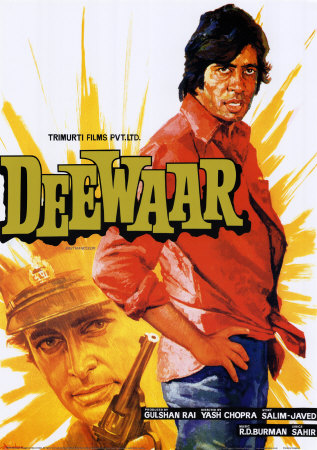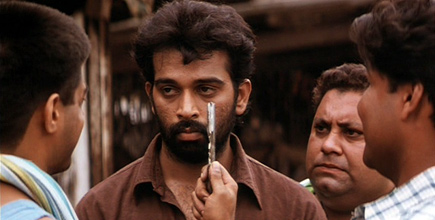|
 By Priyal Sanghavi By Priyal Sanghavi
The Mumbai mafia is an integral part of Mumbai culture. It started in 1940 when Afghan gang lords opened whorehouses exclusively for the ruling British. Soon their activities included smuggling, extortion and contract killing. The mafia kept up with the changing city, rapidly establishing a hold over it with much blood spilt in the process.
The 1980s and 1990s were particularly marked by increased gangland activity. One of the biggest dons, Dawood Ibrahim, was allegedly behind the 1993 Mumbai bomb blasts which claimed 150 lives, while the subsequent riots, fanned by the mafia, claimed a further 257 lives.
The mafia life has been chronicled extensively by Bollywood, but the treatment meted out to the gangs has varied at different times. The dons, their lives and the functioning of the mafia is showcased frequently in popular culture either as part of a larger setting, or as the topic of the entire film.
 The two iconic mafia movies of the 1970s were Deewar and Don. Deewar cast actor Amitabh Bachchan as an underworld ringleader, while Don (again with Bachchan) focused on the glamorous lifestyle of an underworld kingpin surrounded by his female moll and loyal cronies and wanted by the police. The film's most famous dialogue captures the mafia’s reputation: “Don ko pakadna mushkil hi nahi, naa mumkin hai” (“It is not just tough to catch the don, but impossible”). The two iconic mafia movies of the 1970s were Deewar and Don. Deewar cast actor Amitabh Bachchan as an underworld ringleader, while Don (again with Bachchan) focused on the glamorous lifestyle of an underworld kingpin surrounded by his female moll and loyal cronies and wanted by the police. The film's most famous dialogue captures the mafia’s reputation: “Don ko pakadna mushkil hi nahi, naa mumkin hai” (“It is not just tough to catch the don, but impossible”).
Sanjay Gupta, a producer-director who is known for his stylised action movies, says: “Earlier in this genre, Bollywood was only aping the West. Our underworld was largely dacoits. We started having this particular theme of Mumbai mafia only from the 80s onwards.”
But Gupta is blunt about the accuracy of the Bollywood plotlines: “We have never gotten realistic because what is real is very unglamorous, stark and boring. The way actual gangsters live has nothing to do with what we show.”
The man who changed this glamorisation of the underworld was Ram Gopal Varma. He entered the industry with the romantic superhit Rangeela, but went on to create some of the most critically acclaimed movies of the underworld. The key feature common to them all? Realism.
Since childhood, Ramu, as he is popularly known, was drawn to power. He believes this is where his underworld fascination comes from. “You may be a social peace-loving person but you are still attracted to someone in power, whether to you look up or down at him. In school, one is scared of bullies. In a neighbourhood, if there is a gangster who lives by his own rules, good or bad, you can’t ignore him. That’s power,” he says.
His first foray into the underworld was Satya in 1998. Ramu discusses the background: “In 1997, a man was killed by gangsters. I happened to be with a policeman friend who was discussing what the victim was up to before he died.
“There it struck me, what about the killer? What was he doing before he committed the crime? Did he have breakfast? I realised the only time we ever heard about the killers was when they committed the crime or were caught by the police.”
 Satya chronicles the life of Chakravarthi (played by JD Chakravarthy), an honest man jailed for no reason who soon becomes a most-wanted hitman. He also falls in love with struggling singer Vidhya, who is unaware of his profession. As the police close in on him, the film focuses on his attempts to convince Vidhya to escape with him. Satya chronicles the life of Chakravarthi (played by JD Chakravarthy), an honest man jailed for no reason who soon becomes a most-wanted hitman. He also falls in love with struggling singer Vidhya, who is unaware of his profession. As the police close in on him, the film focuses on his attempts to convince Vidhya to escape with him.
Despite having two very strong writers in Anurag Kashyap and Saurabh Shukla, Ramu believes the film’s realism was a result of its improvised script.
Satya shook the industry. Never before had Bollywood reality actually been real. Sunday Mid Day hailed it as “India’s first gangsta film attempting to penetrate the whys of criminality”. The Times of India gave it a five-star rating saying “nothing but the truth.” Film critic and film trade analyst Komal Nahata describes it as “landmark and cult”.
Ramu’s next underworld venture, Company, explained the workings of the underworld inspired by the real life don Dawood Ibrahim and his famous split from associate Chota Rajan. The movie’s precise portrayal of the don’s business model was praised, while Manisha Koirala and Antara Mali’s characters showed the change in depiction of mafia women. The underworld moll, who had previously been included to raise the glamour and sex quotient, was now an intelligent woman aware of her partner’s profession, providing input and emotional support.
The next big mainstream underworld movie was Farhan Akhtar’s Don, a remake of the 1970s hit this time featuring superstar Shah Rukh Khan. It returned to the stylised and extravagant approach of previous Bollywood mafia. It fared well in India while doing big business internationally. Kohal Nahata attributes this to the Shah Rukh Khan factor: “The international audiences love him”.

Ramu’s film budgets have been rather modest by Bollywood standards. By contrast, Sanjay Gupta is known for his lavish sets, multi-star casts and no-expenses-spared budgets. He believes there is definitely a market for his genre. “If these films didn’t work, I wouldn’t be sitting in this grand office right now.”
Nahata believes mafia movies can still be profitable, but don’t expect a blockbuster. “There is a section of audience who wants reality but 90 per cent of Indians still want their cinema to be ‘masala’ entertainment,” he says.
“The international audience is more traditional, preferring song-and-dance, ostentatious weddings and typical Indian milieu films. Hence movies on the underworld have a limited appeal not appealing to a wide spectrum of audience.”
Meanwhile, the Mumbai underworld itself has declined. The mafia suffered from fragmentation during the late 1990s and by 2001, while very much still alive, had lost much of the strength it had built over six decades, leaving the worst of the violence to the Bollywood scriptwriters.
|

